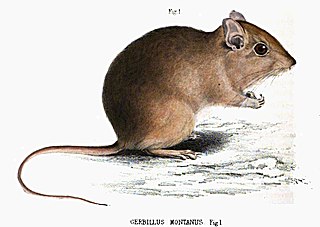
Gerbillinae is one of the subfamilies of the rodent family Muridae and includes the gerbils, jirds, and sand rats. Once known as desert rats, the subfamily includes about 110 species of African, Indian, and Asian rodents, including sand rats and jirds, all of which are adapted to arid habitats. Most are primarily active during the day, making them diurnal, and almost all are omnivorous.

The fat-tailed gerbil, also called the duprasi gerbil or doop, is a rodent belonging to the subfamily Gerbillinae. It is only species in the genus Pachyuromys. They are frequently kept as pets.

Dipodillus is a genus of rodent in the family Muridae. It is sometimes classified as a subgenus of the genus Gerbillus.

Gerbillurus is a genus of rodent in the family Muridae. It contains the following species:
The Namib brush-tailed gerbil or Setzer's hairy-footed gerbil is a species of rodent endemic to Angola and Namibia. Its natural habitats are sandy and gravelly plains. It stays in its burrow by day, emerging at night to feed on arthropods, vegetable matter, and seeds.
The Cape gerbil is a species of rodent found only in South Africa. Its natural habitats are subtropical or tropical dry shrubland and temperate desert.
Boehm's gerbil is a species of rodent found in Angola, Burundi, Democratic Republic of the Congo, Kenya, Malawi, Mozambique, Rwanda, Tanzania, Uganda, and Zambia. Its natural habitats are dry savanna, moist savanna, and arable land. This is a common species with a wide distribution which faces no obvious threats, so in 2004 the International Union for Conservation of Nature rated its conservation status as being of "least concern".

The highveld gerbil is a species of rodent found in Angola, Botswana, Lesotho, Namibia, South Africa, Eswatini, Zambia, and Zimbabwe. Its natural habitats are dry savanna, temperate shrubland, subtropical or tropical dry shrubland, temperate grassland, and temperate desert. This is a common species with a wide range and the International Union for Conservation of Nature has rated it as being of "least concern" as of 2008.
The Guinean gerbil is a species of rodent found in Burkina Faso, Gambia, Ghana, Guinea, Guinea-Bissau, Ivory Coast, Mali, Senegal, Sierra Leone, and possibly Liberia. Its natural habitats are subtropical or tropical dry forests, dry savanna, rocky areas and arable land, but it is mostly found in areas laterite or clay soils, and with variable amounts of vegetation and dense scrub. This species is described as common and has a stable population and a wide distribution, so the International Union for Conservation of Nature has rated its conservation status as being of "least concern".
The Gorongoza gerbil is a species of rodent found in Mozambique, Tanzania, and Zimbabwe. Its natural habitat is moist savanna.

The Indian gerbil also known as antelope rat, is a species of rodent in the family Muridae.

Kemp's gerbil is a species of rodent. Mammal Species of the World considers G. kempi and G. gambianus to be synonyms, however the IUCN has assessed each taxon as were they different species.

The bushveld gerbil is a species of rodent found in Angola, Botswana, Democratic Republic of the Congo, Kenya, Malawi, Mozambique, Namibia, South Africa, Eswatini, Tanzania, Uganda, Zambia, and Zimbabwe. Its natural habitats are dry savanna, subtropical or tropical dry shrubland, subtropical or tropical dry lowland grassland, and hot deserts. Older sources classify it in the genus Tatera.
The black-tailed gerbil is a species of rodent found in Ethiopia, Kenya, Somalia, and Tanzania. Its natural habitats are dry savanna, subtropical or tropical dry shrubland, and arable land.
Phillips's gerbil is a species of rodent found in Ethiopia, Kenya, and Somalia. Its natural habitat is subtropical or tropical dry shrubland.
The fringe-tailed gerbil is a species of rodent found in Central African Republic, Chad, Eritrea, Ethiopia, Kenya, Niger, Somalia, Sudan, Tanzania, Uganda, possibly Cameroon, and possibly Nigeria. Its natural habitats are dry savanna, moist savanna, subtropical or tropical dry lowland grassland, arable land and urban areas.
The savanna gerbil is a species of rodent found in Angola, Burundi, Democratic Republic of the Congo, Ethiopia, Kenya, Mali, Rwanda, Sudan, Tanzania, Uganda, Zambia, and Zimbabwe. Its natural habitats are dry savanna, moist savanna, and arable land.








